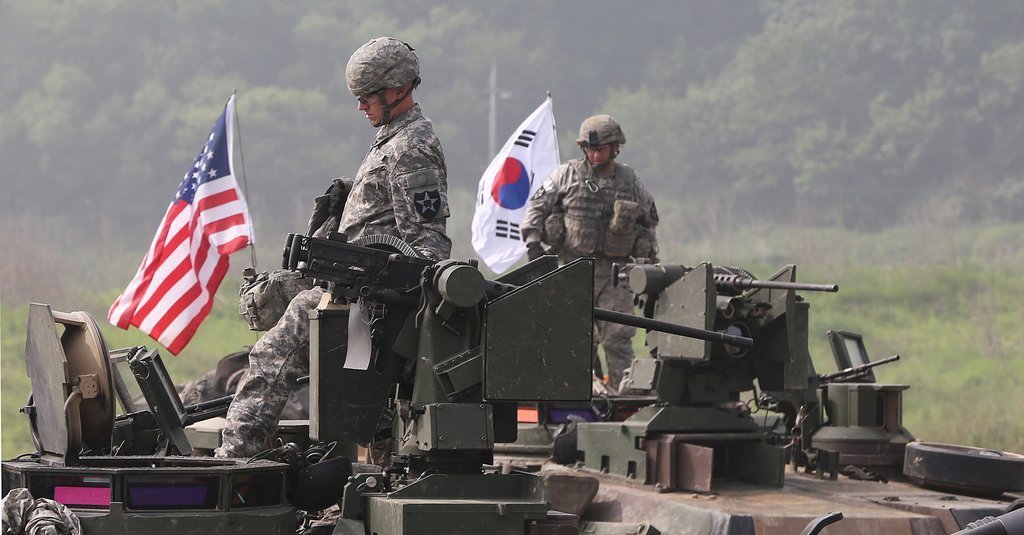Seoul, Washington to conduct scaled-down simulation-only military exercise this week
By Ahn Sung-miPublished : March 7, 2021 - 15:25

South Korea and the United States will stage their annual springtime military exercise this week, but it will be reduced in scope due to the coronavirus pandemic.
The allies decided to hold the computer-simulated Combined Command Post Training for nine days starting Monday and ending March 18, the Joint Chiefs of Staff said Sunday, after “comprehensively” taking into consideration the “COVID-19 situation, the maintenance of the combat readiness posture, the denuclearization of the Korean Peninsula and the establishment of peace.”
The JCS said the exercise will not include outdoor drills or maneuvers, as those have been carried out throughout the year. There will be fewer troops and less equipment than in previous exercises due to the pandemic.
Due to the scaled-back nature of the upcoming drill, a Full Operational Capability test won’t be staged this time, which may force the two sides to postpone the envisioned takeover of wartime operational control from Washington to Seoul.
Seoul has been seeking to complete the OPCON transfer by 2022, before President Moon Jae-in leaves office in May that year.
The allies were planning on completing the FOC test -- the second step in a three-phase verification process to measure Seoul’s readiness for the transfer -- last year. But due to the COVID-19 pandemic, which forced them to cancel the springtime exercise and adjust the summertime one, they were unable to conduct the test in which a South Korean commander would helm the combined defense posture.
With a delayed timetable and uncertainty as to when the two remaining steps will be taken, including the final Full Mission Capability test, it remains unsure whether the handover will happen according to Seoul’s self-imposed timeline.
Washington has emphasized that the transition won’t be time-based, but that the necessary conditions must be met for the handover. The right conditions are South Korea acquiring the necessary military capabilities to lead the combined defense posture, South Korea being able to effectively counter North Korea’s nuclear and missile threats and a stable security environment on the Korean Peninsula and in the region.
The joint exercise, the first of its kind since President Joe Biden took office in January, comes as Washington is conducting a policy review on how to deal with a nuclear-armed North Korea. There have been recent calls to postpone or cease the exercises to improve stalled inter-Korean relations. Pyongyang, which perceives the joint exercises as a hostile act, has routinely responded to past drills with armed provocations.
Observers are concerned that Pyongyang could use the drills, despite their toned-down nature, as a pretext for fresh provocations in the early days of the Biden administration.
Meanwhile, the allies are continuing discussions on how much Seoul should pay for the upkeep of the roughly 28,500 US troops stationed in South Korea. The top negotiators from both sides are holding talks in Washington that are expected to last until Sunday (US time), a day longer than originally planned.
The two sides are expected to soon clinch a deal, known as the Special Measures Agreement, after years of drawn-out talks in which they failed to agree on the price.
US Secretary of State Antony Blinken and Defense Secretary Lloyd Austin are planning to visit South Korea later this month after visiting Japan, according to media reports last week. Blinken and Austin are planning to hold a “two plus two” meeting with their South Korean counterparts during their visit, with the two sides expected to discuss pressing issues including North Korea’s denuclearization. Observers also say the two could sign the defense cost-sharing deal during their visit.
By Ahn Sung-mi (sahn@heraldcorp.com)








![[Kim Seong-kon] Democracy and the future of South Korea](http://res.heraldm.com/phpwas/restmb_idxmake.php?idx=644&simg=/content/image/2024/04/16/20240416050802_0.jpg&u=)








![[KH Explains] Hyundai's full hybrid edge to pay off amid slow transition to pure EVs](http://res.heraldm.com/phpwas/restmb_idxmake.php?idx=652&simg=/content/image/2024/04/18/20240418050645_0.jpg&u=20240418181020)

![[Today’s K-pop] Zico drops snippet of collaboration with Jennie](http://res.heraldm.com/phpwas/restmb_idxmake.php?idx=642&simg=/content/image/2024/04/18/20240418050702_0.jpg&u=)